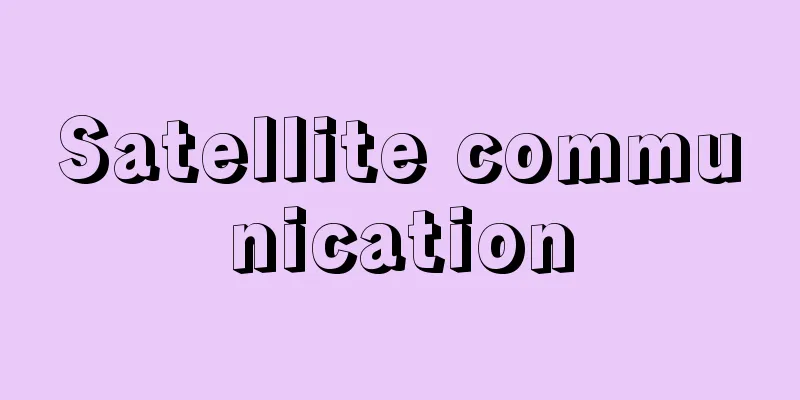Satellite communication

|
Wireless communication between points on Earth via a space station placed on an artificial satellite in space or an object such as the Moon. Basic experiments on using objects in space for communication have been conducted in the United States since 1946, using radio waves reflected by the moon, and in 1959, communication experiments using this method were conducted between the United States and the United Kingdom and between the United States and Canada. However, the method of using the moon as a reflector had poor communication quality and could not be used for practical communication. Meanwhile, after the first artificial satellite was launched by the Soviet Union in 1957, research into communication using artificial satellites progressed rapidly. In 1962, telephone and television communication experiments were successfully conducted between the United States, the United Kingdom, and France using an American artificial satellite (Telstar 1). The first communication experiment in which Japan participated was conducted with the United States in 1963 (Showa 38) using an American artificial satellite (Relay 1). During the television transmission at this time, the news of the assassination of President Kennedy was coincidentally reported, which strongly demonstrated the power of satellite communication to the public. Artificial satellites move along elliptical orbits with the center of the Earth as one of its foci, in accordance with Kepler's laws, but they can be divided into geostationary and non-geostationary satellites depending on how they move when viewed from Earth. The former are in a circular orbit called a geostationary orbit, located along the equator at an altitude of about 35,800 km, and move in the same direction at the same rotational speed as the Earth's rotation, and always appear to be in the same direction from a point on Earth. The latter are satellites in orbits that do not satisfy the former conditions, and do not appear to be stationary from a point on Earth. Both the Telstar and Relay satellites mentioned above are non-geostationary. When using non-geostationary satellites for communication, the disadvantage is that the time during which the satellite can be seen simultaneously from two points on Earth, i.e. the time available for communication, is quite limited. In contrast, by using geostationary satellites, one satellite can be seen simultaneously from approximately one-third of the Earth's surface, and earth stations in this region can communicate with each other around the clock. If geostationary satellites are placed at intervals of 120 degrees on a geostationary orbit, they can cover the entire Earth except the polar regions, making them particularly useful for international communications. However, communications using geostationary satellites have the disadvantage that the distance between the ground and the satellite is long, resulting in long delays in voice and data communications (approximately 240 milliseconds from ground to satellite to ground) and large free space propagation losses. This places a limit on how small the ground terminals can be. In this regard, the non-geostationary Iridium satellite system allows the use of mobile communications systems using small terminals. The Iridium system has 66 satellites in orbit at an altitude of 780 kilometers, and covers the entire Earth through inter-satellite relay. [Shizuo Endo] Geostationary Satellite CommunicationsThe concept of geostationary satellite communications was suggested by British author A.C. Clarke in 1945. Its first practical application was the television broadcast of the 1964 Tokyo Olympics using an American geostationary satellite (Syncom 3). It wasn't until 1965, when the Intelsat 1 satellite (commonly known as Early Bird) was launched, that it began to be used in earnest for international communications. Until then, most international communications were based on shortwave communications. Shortwave communications relies on ionospheric propagation, so the communication quality was sometimes poor and the number of lines was limited. Today, satellite communications can provide large-capacity communications at a relatively low cost, and are therefore widely used not only for international communications but also for domestic communications in various countries, including developing countries. Satellite communications are primarily used for fixed satellite services, that is, communications between earth stations installed at fixed locations on Earth, but since the 1980s, their scope has expanded to include mobile satellite services, that is, communications for moving objects such as ships, aircraft, and vehicles. Satellite communications for ships are called maritime mobile satellite services, and examples of practical global satellite communications systems include the Inmarsat system. Geostationary satellite communications use satellites in geostationary orbit, but to avoid harmful radio interference between different satellite communications systems, there is a limit to the number of satellites that can be placed in geostationary orbit, i.e., their orbital locations. Currently, countries are competing to secure rights to orbital locations, and the International Telecommunication Union (ITU) is devoting considerable effort to managing and coordinating these rights. [Shizuo Endo] Communication methodHere we will discuss communication methods related to satellite communications. Simply put, a communication method is a method of transmitting information via radio waves. In order to communicate, information such as voice and images must be transmitted over radio waves. There are two ways to modulate the original information: either it is modulated as is (analog modulation), or it is converted into a code string of combinations of "1" and "0" as in pulse code modulation (PCM), and then modulated (digital modulation). Since the late 1980s, the latter method has been the mainstream because it allows for more efficient use of radio waves and enables higher quality transmission. The former method commonly used includes amplitude modulation (AM) and frequency modulation (FM), while the latter method commonly uses phase shift keying (PSK) and quadrature amplitude modulation (QAM). There are various PSK methods, such as 2-phase PSK (2PSK), which transmits "1" at 0 degrees and "0" at 180 degrees, and 4-phase PSK (QPSK), which transmits "11" at 45 degrees, "01" at 135 degrees, "00" at 225 degrees, and "10" at 315 degrees. In other words, 4-phase PSK transmits 2 bits per modulation. 8-phase PSK (8PSK), which transmits 3 bits per modulation, is also used. QAM is a modulation method that transmits data by adjusting the amplitude and phase of two independent carrier waves (the phase of the second carrier wave is orthogonal to the phase of the first carrier wave). Higher order 16QAM and 64QAM methods are used. The former is a method that expresses a 4-bit code string as a combination of phase and amplitude, while the latter is a method that expresses a 6-bit code string as a combination of phase and amplitude. Multiple access refers to multiple earth stations simultaneously establishing the necessary communication paths via a common satellite. Common multiple access methods include Frequency Division Multiple Access (FDMA), in which each earth station transmits a carrier wave of a different frequency, and Time Division Multiple Access (TDMA), in which each earth station transmits a carrier wave of the same frequency in a time-division manner. The former method has the disadvantage that the repeater in the space station must simultaneously repeat multiple carrier waves, and the efficiency of the repeater decreases as the number of carrier waves increases. Therefore, the latter method, which does not have this drawback, was developed and put into practical use, but the system becomes complicated and the equipment becomes expensive, so the former method has become mainstream since the 2000s. [Shizuo Endo] Effective use of frequencies and geostationary satellite orbitsThere are limitations on the frequencies available for satellite communications (currently, radio waves in the 4, 6, 11, 14, 20, and 30 GHz bands are commonly used), and the orbital locations for placing geostationary satellites are also limited. As the number of satellite communications systems increases, the amount of radio interference between systems increases, making it difficult to ensure good communication quality, so how to efficiently use frequencies and geostationary satellite orbits has become a major issue. To use frequencies effectively, there are two methods: frequency multiplexing by spatial division and frequency dualization by polarization discrimination. Both methods are already in practical use. These became possible due to the advancement of antenna technology. In the former, instead of emitting a wide-angle beam from a satellite to illuminate the service area, multiple sharp beams are emitted, and each beam uses the same frequency. In the latter, orthogonal polarizations (for example, vertical and horizontal polarizations, or right-handed and left-handed circular polarizations) are used to carry different communication information on the same frequency radio waves, making dual use of the frequency. In addition, the latter method requires excellent polarization discrimination performance from the earth station and satellite antennas, and the deterioration of discrimination due to fluctuations in the polarization state caused by rainfall on the propagation path becomes a problem, so technology to correct the deterioration of polarization discrimination on the propagation path is also in practical use. The problem with orbital utilization is not so much collisions between satellites, but rather restrictions on satellite placement due to radio interference. The ITU is actively researching technical and institutional aspects so that as many satellites as each country desires can be placed on geostationary satellite orbit, but the problem is extremely difficult to resolve due to the involvement of technical and economic factors as well as the interests of each country. Currently, each country is assigned an orbital position for at least one communications satellite (called a plan satellite) by the ITU, but other satellite positions are assigned on a first-come, first-served basis in the order in which the designated procedures are followed by each country. [Shizuo Endo] Expanding use in the broadcasting fieldIn the early days when satellite communications first began to be used, it was only known to the general public for business communications by companies and government agencies, television broadcasts of international events such as the Olympics, and international telephone calls. However, in 1989 (Heisei 1), private satellite communications companies Japan Communications Satellite Corporation (JCSAT) and Space Communications Corporation (SCC) launched their own satellites and began offering a variety of broadcasting-related services, including SNG (satellite news gathering) and program distribution to CATV (satellite cable television), which attracted a great deal of attention. Furthermore, in 1992, CS (satellite communication) television broadcasting, which could be received directly and individually at home, began, and the scope of satellite communications use expanded to an unprecedented extent. Until then, broadcasting satellites (BS) were used for broadcasting, and communication satellites were used for other communications, with a clear institutional division. However, the number of channels on a broadcasting satellite was limited, and in order to expand satellite broadcasting, it became necessary to use communication satellites for broadcasting purposes as well. Against this backdrop, the Broadcast Act was revised in 1989, and a new broadcasting system consisting of commissioned broadcasters and entrusted broadcasters was introduced. Until then, the hardware side of broadcasting (transmission facilities, etc.) and the software side (program supply, etc.) had been considered to be one entity under the system, but only in the case of communication satellites was this unity broken down and separation of hardware and software permitted. The system works like this: commissioned broadcasters who supply software have the commissioned broadcasters, who own the communication satellite system, broadcast their programs. Broadcasting under this system began in 1992. As of 1999, two CS digital broadcasting services, Sky Perfect TV and DirecTV, were established as satellite television broadcasting services, but in 2000, DirecTV was merged into Sky Perfect TV. After some changes, JCSAT, SCC, and Sky Perfect TV became one company, Sky Perfect JSAT, in 2008. This resulted in a monopoly on Japan's CS digital broadcasting business. As of May 2011, the total number of subscribers was about 3.74 million, the number of channels was about 300, and in addition to standard image quality, high vision and three-dimensional stereoscopic image quality were added, making it a powerful driving force in the age of multi-channel and high quality. It is also a leading form of broadcasting media in the digital age, and is attracting attention as a medium that will have a major influence on the future direction of broadcasting as a whole. [Kazuhiko Goto and Shizuo Endo] [Reference items] | | | | | | |Source: Shogakukan Encyclopedia Nipponica About Encyclopedia Nipponica Information | Legend |
|
宇宙空間にある人工衛星に置かれた宇宙局あるいは月などの物体を介して、地球上のある地点の間で行う無線通信。 宇宙空間にある物体を通信に利用する基礎実験は、1946年からアメリカで月による電波の反射を利用して行われ、1959年にはこの方式による通信実験がアメリカ―イギリス間、アメリカ―カナダ間で行われた。しかし、月を反射体とする方式は、通信品質が悪く実用通信には利用できなかった。一方、1957年にソ連によって初の人工衛星が打ち上げられてから、人工衛星を利用する通信の研究が急速に進められるようになった。1962年には電話およびテレビジョンの通信実験が、アメリカの人工衛星(テルスター1号)を利用してアメリカ、イギリス、フランスの間で成功裏に行われた。日本が参加した最初の通信実験は、1963年(昭和38)にアメリカの人工衛星(リレー1号)を利用してアメリカとの間でなされた。このときのテレビジョン伝送では、偶然にもケネディ大統領暗殺のニュースが速報され、衛星通信の威力を人々に強く示すことになった。 人工衛星は、ケプラーの法則に従い、地球の中心を焦点の一つとした楕円(だえん)軌道に沿って移動するが、地球上から眺めたときの衛星の移動の仕方によって、静止衛星と非静止衛星とに分けられる。前者は赤道に沿って、高度約3万5800キロメートルのところにある対地静止軌道といわれる円軌道上にあり、地球自転と同じ回転速度で同じ方向に動き、地上の1地点からはつねに同じ方向に見える。後者は前者の条件を満たさない軌道上にある衛星をいい、地上の1地点からは静止しているようには見えない。 先に述べたテルスター、リレーの両衛星はいずれも非静止衛星である。非静止衛星を使って通信する場合、地球上の2地点から衛星が同時に見える時間、すなわち通信に利用できる時間がかなり限定されるという欠点がある。この点、静止衛星を利用すれば、地球表面のほぼ3分の1の地域から、一つの衛星を同時に見ることができ、この地域にある地球局は四六時中互いに通信することができる。静止衛星を静止軌道上120度の間隔で配置すれば、極地方を除く地球の全域をカバーできるので、国際通信にとくに有用である。 しかし、静止衛星を用いる通信には、地上と衛星間の距離が長いため、音声・データの通信に長い遅延が生じ(地上―衛星―地上で約240ミリ秒)、かつ自由空間伝搬損失が大きいという欠点がある。そのため、地上端末の小型化には限界がある。その点、非静止のイリジウム衛星システムでは、小型端末による携帯通信システムが利用できる。なお、イリジウムシステムは66個の衛星を高度780キロメートルの軌道に配置し、衛星間中継により地球全域をカバーしている。 [遠藤静夫] 静止衛星通信静止衛星通信の概念は、1945年イギリスの作家A・C・クラークによって示唆されていた。実用で最初に注目されたのは、アメリカの静止衛星(シンコム3号)を用いた1964年の東京オリンピックのテレビジョン中継である。国際通信に本格的に利用され始めたのは、1965年にインテルサット1号衛星(通称アーリーバード)が打ち上げられてからである。それまでの国際通信は、ほとんどが短波通信によっていた。短波通信は電離層伝搬に依存しているので、ときとして通信品質が悪く、また回線数も多くとれなかった。現在では衛星通信は、国際通信のみならず大容量の通信を比較的廉価で提供することができるため、開発途上国も含め、各国の国内通信にも広く利用されている。 衛星通信は固定衛星業務、すなわち地球上の固定地点に設置される地球局間の通信に多く用いられているが、1980年代以降、移動衛星業務すなわち船舶・航空機・車体などの移動体を対象とする通信にもその範囲が広がりつつある。船舶を対象とする衛星通信は海事移動衛星業務とよばれ、世界的な実用衛星通信システムとしてインマルサット・システムなどがある。 静止衛星通信は静止軌道上の衛星を利用するが、異なる衛星通信システム間の有害な電波干渉を避けるため、静止軌道上に配置できる衛星の数、すなわち軌道位置には限界がある。現在、各国が競って軌道位置の権益確保に動いており、国際電気通信連合(ITU)ではその管理・調整などに相当の労力を費やしている。 [遠藤静夫] 通信方式ここでは、衛星通信に関係する通信方式について述べる。通信方式とは、簡単にいえば電波に情報をのせる方式である。 通信を行うためには、音声・画像などの情報を電波にのせる必要があるが、音声・画像などの原情報をそのまま変調(アナログ変調)する場合と原情報をパルス符号変調のように「1」と「0」の組合せの符号列に変換したのち変調(デジタル変調)する場合がある。1980年代後半以降、電波の有効利用が図られ、かつ高品質の伝送が可能となる理由から後者の方式が主流となっている。前者の方式では、振幅変調amplitude modulation(AM)方式および周波数変調frequency modulation(FM)方式が、後者の方式では、位相偏移変調phase shift keying(PSK)方式および直角位相振幅変調quadrature amplitude modulation(QAM)方式などが一般的に用いられている。 PSK方式には、「1」を0度、「0」を180度の位相で送る2相PSK(2PSK)方式、「11」を45度、「01」を135度、「00」を225度、「10」を315度と四つの位相で送る4相PSK(QPSK)方式などがある。すなわち、4相PSK方式では1回の変調で2ビット伝送するものである。1回の変調で3ビット伝送する8相PSK(8PSK)方式なども利用されている。 QAM方式は、互いに独立した二つの搬送波(二つ目の搬送波の位相は一つ目の搬送波の位相と直交関係にある)の振幅および位相を調整することによってデータを伝達する変調方式である。高次の16QAM、64QAM方式などが利用されている。前者は、4ビットの符号列を位相、振幅の組合せで、後者は6ビットの符号列を位相、振幅の組合せで表す方式である。 複数の地球局が共通の衛星を介して、同時に必要な通信路を設定することを多元接続という。一般的な多元接続には、地球局ごとに異なった周波数の搬送波を送出する周波数分割多元接続(FDMA)方式と、各地球局が同じ周波数の搬送波を時間分割で送出する時分割多元接続(TDMA)方式とがある。前者の方式では、宇宙局の中継器は複数の搬送波を同時に中継する必要があり、搬送波の数が増えるにつれて中継器の効率が劣化するという欠点がある。そこでこのような欠点のない後者の方式が開発され、実用化されたが、システムが複雑になり、装置の価格が高価になるため、2000年代に入ると前者の方式が主流となってきている。 [遠藤静夫] 周波数、静止衛星軌道の有効利用衛星通信に利用できる周波数には限りがあり(現在は4、6、11、14、20、30ギガヘルツ帯の電波が一般に使用されている)、また静止衛星を配置する軌道位置も限定されている。衛星通信システムの数が増えるにつれてシステム間の電波干渉量が増加し、良好な通信品質の確保がむずかしくなるため、いかに効率よく周波数および静止衛星軌道を利用するかが大きな課題となっている。 周波数を有効に利用するには、空間分割による周波数多重使用と、偏波識別による周波数二重使用との方法があり、両者ともすでに実用化されている。これらはアンテナ技術の進歩によって可能になったもので、前者は、サービス範囲を照射するのに衛星から広角度のビームを放射するかわりに、複数の先鋭なビームを放射し、各ビームで同一の周波数を利用する。後者は、互いに直交する偏波(たとえば、垂直偏波と水平偏波あるいは右旋円偏波と左旋円偏波)を用い、同一周波数の電波に別々の通信情報をのせて周波数を二重に利用する。後者の方式では、地球局および衛星アンテナに優れた偏波識別の性能が要求されるほか、伝搬路における降雨などによる偏波状態の変動に伴う識別度劣化が問題となるため、伝搬路における偏波識別の劣化を補正する技術も実用化されている。 軌道利用の問題は、衛星どうしの衝突よりも、電波干渉による衛星配置の制約にある。静止衛星軌道上に、各国の要望に沿った多くの衛星を配置できるよう、ITUで技術面、制度面から盛んに研究されているが、技術的、経済的な要因のほかに各国の利害関係が絡むため、解決はきわめてむずかしい問題となっている。現在、各国に少なくとも一つの通信衛星(プラン衛星といわれる)用の軌道位置がITUで割り当てられているが、その他の衛星位置は、先願主義でITUに所定の手続をとった順に割り当てられることになっている。 [遠藤静夫] 放送分野での利用拡大衛星通信が利用され始めた初期のころは、企業や官庁などの業務用通信、オリンピックなど国際的イベントのテレビ中継、あるいは国際電話の範囲でしか一般の人々に知られていなかった。しかし1989年(平成1)には、日本でも民間の衛星通信会社、日本通信衛星(JCSAT)と宇宙通信(SCC)が自社の衛星を打ち上げ、SNG(サテライト・ニューズ・ギャザリング)やCATVへの番組配信(サテライト・ケーブルテレビ)をはじめとして放送に関係のある多彩なサービスを開始、大きな注目を集めるようになった。さらに1992年には、家庭などで直接に個別受信ができるCS(通信衛星)テレビ放送も開始され、衛星通信の利用範囲はかつてない広がりをもつに至った。 それまでは放送のためには放送衛星broadcasting satellite(略称BS)が利用され、それ以外の通信には通信衛星が使われる、という制度的な振り分けがはっきり設定されていた。しかし放送衛星のチャネル数には限りがあり、衛星経由の放送を拡大するためには、通信衛星を放送目的にも使用することが必要になってきた。こうした事情を背景として1989年に放送法等の改正が行われ、受託放送事業者および委託放送事業者からなる新しい放送制度が導入された。それまで放送のハード面(送信設備など)とソフト面(番組供給など)は制度上一体のものとしてとらえられてきたが、通信衛星利用の場合に限り、この一体性を解体し、ハードとソフトの分離が認められることになったのである。ソフトを供給する委託放送事業者は、通信衛星システムを所有する受託放送事業者に放送してもらう、という仕組みである。 この制度導入による放送は1992年に開始された。1999年の時点ではスカイパーフェクTVとディレクTVの二つのCSデジタル放送が通信衛星利用のテレビ放送として定着していたが、2000年(平成12)ディレクTVはスカイパーフェクTVに統合された。なお、JCSAT、SCC、スカイパーフェクTVは、変遷を経て、2008年にスカパーJSAT(ジェイサット)という一つの会社になった。これにより日本のCSデジタル放送事業は1社独占の状態となった。2011年5月時点の総加入者数は約374万、チャネル数は約300になり、画質についても標準のほかに、ハイビジョン、三次元の立体画質が加わり、多チャネル・高品質時代の強力な牽引車(けんいんしゃ)となっている。またデジタル時代の放送メディアとして先行する形態となっており、今後の放送全体の行方に大きな影響力をもつものとして注目されている。 [後藤和彦・遠藤静夫] [参照項目] | | | | | | |出典 小学館 日本大百科全書(ニッポニカ)日本大百科全書(ニッポニカ)について 情報 | 凡例 |
<<: Hygiene Statistics - Hygiene Statistics
Recommend
tyurya
...Today, except in special cases, there is littl...
Death Valley
It is also called "Death Valley." It is ...
《Kanki》
…At that time, power had already shifted to Cao C...
Planetary coordinates - planetocentric coordinates
Just as longitude and latitude are used to indicat...
Asclepius
…The ancient Hermetic texts were apparently enorm...
River Ouse
A river in the eastern part of England. It is also...
Diwan al-maghrib (English spelling)
...During the Abbasid Caliphate (750-1258), the c...
Guidelines for taking notes on school records
...The Ministry of Education explains that it is ...
polar orbit
... Based on their shape, satellite orbits are cl...
Kikugawa
This is a former town area in the north of Kikugaw...
Kalan
...In Champa, where Hinduism was more prevalent t...
unilineal descent
…There are two types of descent that can be trace...
"Neuer Vorwarts" (English spelling)
…Because its publication was banned under Bismarc...
Differentiation - Bunka
〘noun〙① When something simple divides internally, ...
Soda lime - soda lime
It is made by soaking calcium oxide (quicklime) i...









![Westray [island] - Westray](/upload/images/67cf80cc8dc3f.webp)